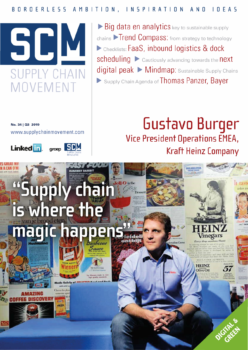Supply chain digitalization: cautiously advancing towards the next peak

We are in the midst of the transition from one era to the next: moving from the computer age into the digital age, which is dominated mainly by artificial intelligence. Caution is advised during this transition; we should keep our eyes fixed firmly on the path ahead and advance with care, continuously checking that we are on stable ground. Deviating too far from the path could prove fatal.
By Marcel te Lindert
A photo of New York’s 5th Avenue dating from 1908 was projected onto the big screen at this year’s inNOWvate Supply Chain Event. The photo showed a street full of horse-drawn carriages. On the next photo, taken less than five years later, all the horses had made way for cars. Those photos during Sean Culey’s keynote speech illustrated that the current period of rapid change is nothing new. “But what makes things different this time around is the disruptive force of the technologies that are driving these changes,” said Culey, author of the book called Transition Point.
“That disruptive force stems from the fact that we now have machines which are replacing not only jobs, but also typically human skills. Besides that, compared to the past, globalization and digitalization mean that the changes are spreading more widely across different continents and sectors. Things are moving so fast that people don’t have much time to adapt and retrain. Take a middle-aged truck driver, for example – his job is set to become obsolete in the longer term due to the rise of autonomous vehicles. For someone who is specialized in a single role and still has 20 years to go until he retires, it will be difficult to change direction. That’s making people angry at a world in which they thought they were playing by the rules, only to discover that the rules have been changed.”
Recurring pattern
In his book, Culey illustrates that these times of rapid change are part of a recurring pattern comprising long-term cycles of economic boom followed by depression. They are called ‘Kondratiev waves’ after the Russian economist Nikolai Kondratiev. Each wave starts with a period of innovation in which major new technologies emerge, often relating to areas such as energy supply, communication or transport. Those technologies trigger a period of growth in which new sectors are formed around these technologies and existing businesses based on old technologies disappear.
As the new technologies become more established, the rate of growth slows and competition increases. That is when the focus shifts from innovation to efficiency and cost leadership. Ultimately, investment moves to more exciting areas such as high-risk financial products. Demand levels off and companies exhaust the opportunities to reduce costs. The market collapses, leading to bankruptcies and job losses. That creates room for new inventions, new scientific breakthroughs and, ultimately, the next wave. “The impact of each new wave is bigger than the ones preceding it. First and foremost, the waves are coming in ever-quicker succession. At the same time there is a growing number of innovations per wave, and those innovations are spreading faster and over greater distances than before,” according to Culey, who spent five years conducting research.
The sixth wave
The global financial crisis marked the end of the fifth wave: the age of computers and the internet. We are now on the cusp of a new wave – the sixth – and a new era: a digital age in which artificial intelligence and robotics are the dominant technologies. This transition will be accompanied by a fundamental paradigm shift. “So far, the power has always been in the hands of the companies who decided which products to make, where to sell them and how to market them – think of the traditional television networks that decide which programme to broadcast on which channel at which time. But we’re now seeing the rise of the Netflix generation in which people decide for themselves what to watch when, and how.” … … …
 Want to read more?
Want to read more?
Subscribe to the digital subscription to read the full version >>
or
select one of our annual or digital subscriptions to receive the next issue >>
This article was first published in Supply Chain Movement 34 | Q3 – 2019










